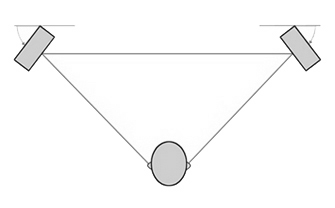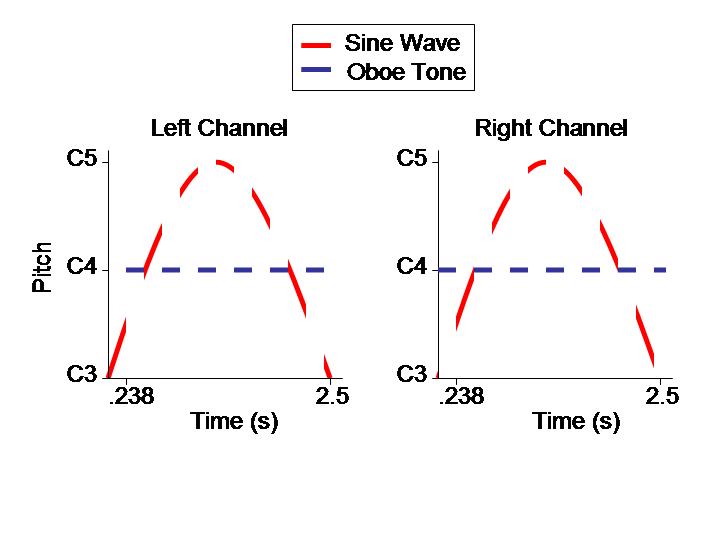ASA/CAA '05 Meeting, Vancouver, BC



[ Lay Language Paper Index | Press Room ]
The Glissando Illusion: A Spatial Illusory Contour in
Hearing
Diana Deutsch - ddeutsch@ucsd.edu
Department of Psychology
University of California San Diego
La Jolla, CA 92093, USA.
Kamil Hamaoui
Department of Psychology
University of California, San Diego
La Jolla, CA 92093, USA.
Trevor Henthorn
Department of Music
University of California, San Diego
La Jolla, CA 92093, USA.
Popular version of paper 3aMU3
Presented Wednesday Morning, May 18, 2005
ASA/CAA '05 Meeting, Vancouver, BC
Picture yourself sitting at a sidewalk cafe. Traffic rumbles past you along
the street. Pedestrians stroll by, engaged in lively conversation. Waiters
clatter dishes as the food is served, and music emanates softly from inside
the building. We perceive all these sounds so effortlessly that it is tempting
to think of our ears as microphones and our brain as a passive recorder of
the signals that are sent up from our ears. But the process of sound perception
is necessarily far more complicated. Sounds are subject to numerous distortions
as they travel from their sources, and are mixed in the air before they reach
our ears. So our brain is faced with the extraordinarily difficult task of
reconstructing the original sounds from the complex signals that it receives.
In performing this task we employ many different cues, which enable us to
make 'best guesses' about the sounds around us. For the most part,
this process of hypothesis formation works very well, but with some sound
patterns it causes us to experience striking illusions instead.
We here report the first formal experiment on an illusion known as the glissando
illusion, which was discovered and demonstrated in the compact disc Musical
Illusions and Paradoxes by Deutsch (1995). The illusion shows how a cue
that is generally very useful in enabling us to form correct perceptions can
instead lead to perceptions that are wildly wrong. It also shows that a simple
sound pattern can be perceived by different people in strikingly different
ways.
|

Figure 1. Seating
arrangement for experiencing the glissando illusion. The listener is
seated in front of two loudspeakers, with one to the left and the other
to the right. |
To experience the glissando illusion, you should be seated in front of two
stereophonically separated loudspeakers, with one to your left and the other
to your right, as in Figure 1. The pattern that gives rise to the illusion
consists of two components: A synthesized oboe tone of constant pitch (the
oboe tone), and a sine wave that repeatedly glides up and down in pitch -
rather like a siren (the glissando). The two components are presented simultaneously
through the two loudspeakers, and are constantly switching from speaker to
speaker such that when the oboe tone is coming from the speaker on the right
a portion of the glissando is coming from the speaker on the left; and vice
versa. A fragment of this pattern is illustrated in Figure 2.

Figure 2. Fragment
of the pattern that gives rise to the glissando illusion, as it was
presented in the experiment.
|
Click
here to listen to the illusion that was originally presented by Deutsch
(1995). (Set the sound level so that it is on the soft side, and make sure
that the channels are in balance.) Notice that when only one channel is played
- either the left or the right one - you correctly hear the oboe tone alternating
with a portion of the glissando. However when both channels are played together,
for most people the experience changes dramatically: The oboe tone is heard
correctly as switching back and forth between the loudspeakers. However, the
portions of the glissando appear to be joined together quite seamlessly, so
that a single, continuous tone is heard that appears to be moving around in
space in accordance with its pitch motion. Notice, also, that as the rate
of switching between the oboe tone and the glissando speeds up and slows down,
the apparent speed at which the glissando appears to move through space remains
constant, and tied to its pitch motion.
In our formal experiment, the oboe tone was at Middle C (262 Hz) and the
sine wave glided up and down in pitch between the octave below Middle C (131
Hz) and the C an octave above (523 Hz). The switching rate between the glissando
and oboe tone was held constant at 238 ms, and the duration of one cycle of
the glissando was held constant at 2.5 sec. We chose these parameters so that
the spatial positions of the glissando when its pitch was highest and lowest
would vary throughout the sequence.
Sixty-four listeners with normal hearing listened to this pattern. They
were designated as 'righthanded' or as 'nonrighthanded'
depending on their responses to a handedness questionnaire. The listeners
were tested individually, and were seated as in Figure 1. They listened to
the pattern first facing the loudspeakers, and then facing the opposite direction.
They reported verbally what they heard, and backed up their verbal descriptions
with diagrams.
All the listeners correctly heard the oboe tone as switching back and forth
between the loudspeakers. However, the way the glissando was perceived varied
from one listener to another. Most righthanders heard it as moving from left
to right as its pitch moved from low to high, and as moving from right to
left as its pitch moved from high to low. This percept occurred regardless
of whether the listener was facing the loudspeakers or facing the opposite
direction. Other listeners heard the glissando move around in different ways;
for example as moving from right to left as its pitch moved from low to high,
or even moving between front and back. Interestingly righthanders and nonrighthanders
differed statistically in terms of how they perceived this pattern.
Many listeners also reported that as the pitch of the glissando moved from
low to high it appeared to move upward in space, and as its pitch moved from
high to low it appeared to move downward. The interaction between the apparent
spatial motion along the left-right and the up-down dimensions caused many
righthanders to perceive the glissando as tracing an elliptical path that
was aligned diagonally between a point low and to the left when its pitch
was lowest and a point high and to the right when its pitch was highest. This
illusory percept is illustrated in Figure 3, which reproduces the diagram
that was drawn by one of the listeners.

Figure 3.
Diagram drawn by a listener to illustrate his perception of the glissando
illusion.
|
Perhaps the most remarkable aspect of this illusion is that, although the
portions of the glissando are alternating abruptly between widely different
spatial positions, it is perceived as though coming from a single source that
moves around in space in accordance with it pitch characteristics. This provides
an instance of the brain making a plausible but incorrect 'best guess' about
the signals it receives. In everyday life, when we hear a sound that changes
slowly in pitch - such as a siren - it is much more likely to be coming from
a single source which is either stationary or moving slowly in relation to
us, rather than to be alternating rapidly between two widely separated sources.
The brain therefore bets on the cues of pitch proximity and pitch continuity
between successive portions of the glissando, so as to conclude that it is
coming from a single source that is moving slowly through space. The illusion
also provides an example of striking differences in sound perception that
vary in association with the handedness of the listener, and so reflect differences
in brain organization.
[ Lay Language Paper Index | Press Room ]
![]()
![]()
![]()


